Why pressure drops in a gas boiler: causes of instability of pressure + ways to prevent problems
Work to ensure the proper functioning of heating equipment does not end with its installation. Maintenance requires the owner a certain level of knowledge and constant monitoring of the state of the system. It is important to understand why the pressure in the gas boiler drops or rises, why the equipment operates with differences.
In our article, we describe in detail all the causes of pressure instability in the preparation system for the coolant and hot water. We’ll show you how to troubleshoot and maintain performance in the normal range. Our recommendations will help to cope with emerging breakdowns and prevent malfunctions.
The content of the article:
- What should be the pressure in the heating system
- How to check the pressure in the boiler and circuit
- Reasons for pressure increase in a gas boiler
- Pressure increase in the heating circuit
- The main reasons for reducing pressure
- How accumulator operation affects pressure
- Conclusions and useful video on the topic
What should be the pressure in the heating system
Heating systems can be divided into two types - closed and open. In the open, the pressure control function is performed by an unpressurized expansion tank.
The tank is installed at the upper point of the heating circuit and serves to hold the heat carrier expanding during heating, to remove air, and also acts as a safety valve. The operating pressure in such a system depends mainly on the temperature of the heating water.
Most often, with organization of heating in homes and apartments, use closed heating systems. They are more effective, safe, but require constant pressure monitoring.
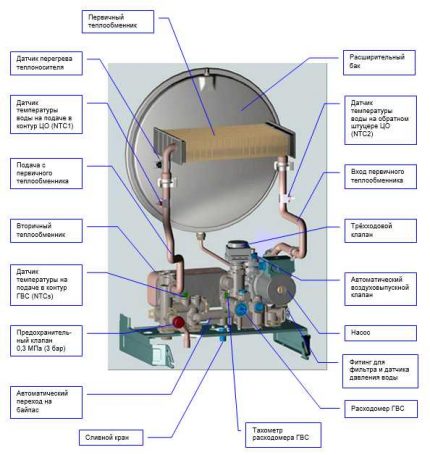
The pressure in the closed circuit is due to forced circulation by the pump.Abnormalities in pressure can result in equipment failure.
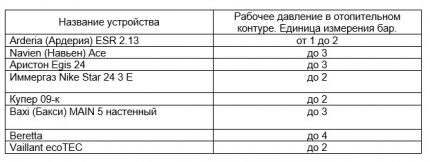
When designing a heating system, the pressure is calculated taking into account the height of the water column, the length of the system, the characteristics of the connected equipment, and the cross-section of the pipes.
To adjust working pressure You need to focus on the following parameters:
- Technical characteristics of a gas boiler. The manufacturer indicates the capabilities of the equipment and its settings in the instructions.
- Coolant temperature. The higher the temperature, the greater the pressure in the circuit; when it decreases, it decreases. Therefore, the adjustment and measurement of pressure in the gas boiler and heating circuit must be carried out before and after heating the coolant.
- Volume of the circuit and expansion tank. The size of the accumulator has a direct effect on the pressure in the heating circuit, on the range of its fluctuations.
- Permissible pressure indicators for the least "weak" element "of the system. The pressure in the system must not exceed the permissible values for each of its elements. For example, polypropylene pipes, which are designed on average for a pressure of 25 bar at room temperature, can withstand a pressure increase of up to only 7–9 bar at a temperature of 90 ° C.
The minimum pressure in the circuit can be 0.5-0.8 bar, the exact standard values are indicated in the instructions, in accordance with them, the pressure sensor is adjusted to the required value. If the pressure in the heating system drops below 0.5 bar, an emergency situation occurs in which the gas boiler may stop or be damaged.
The highest pressure in the system is up to 3, less often up to 4 bar. For a five-story building, pressure values of up to 5 bar are set, for a ten-story building, up to 7 bar. When adjusting, it is necessary to adhere to the difference in pressure between the outgoing and return pipes - it should be 0.3-0.5 bar. After starting heating, check if this is the case.
How to check the pressure in the boiler and circuit
Pressure monitoring in the system is carried out using instruments that measure and reflect the pressure in the circuit using a digital or mechanical dial. Sensors are installed by the manufacturer on the boiler outlet.
During installation of the system manometers also installed near the collectors, which distribute the coolant in various parts or floors of the building.
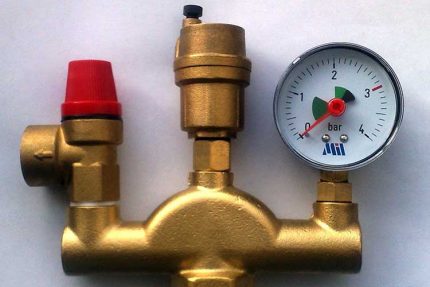
Additional pressure control is required when using boilers for heating water in underfloor heating systems. A drop or increase in pressure can be observed differently in different parts of the heating system.
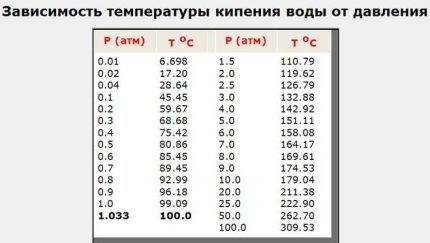
When starting the gas boiler, the pressure gauge is checked while the heating water is still cold - the pressure should not be lower than the minimum value indicated by the red adjustable gauge needle. The adjustment is carried out by a representative of the company with which the gas service and supply contract is concluded.
The initial setting is carried out the first time the heating is started. In the future, the pressure is checked every week, if necessary, feed the system with water. Make-up is carried out at a coolant temperature below 40 ° C.
Reasons for pressure increase in a gas boiler
In addition to the pressure gauge, a frequent discharge of water through the safety valve and blocking the operation of the device help to detect the increase in pressure in the gas boiler.Having determined high pressure, first of all, they dump excess air through Mayevsky cranes and turn off the boiler. The causes of malfunctions can be several.
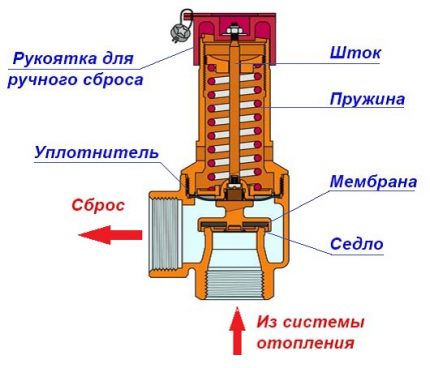
Damage to the secondary heat exchanger partition, which serves both to isolate and increase the contact area of two circuits — heating and hot water supply, can lead to increased pressure in the gas boiler.
A secondary heat exchanger draws water from the heating circuit for the preparation and supply of hot water to double-circuit boiler. Damage to the partition leads to the forcing of water from the DHW circuit into the heating system, increasing the pressure in it.
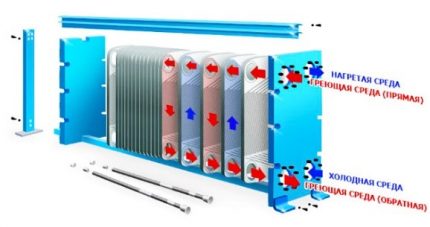
Replacing the heat exchanger will solve the problem. It is possible to carry out repairs yourself, but it is undesirable to do this, since interference in the operation of gas equipment requires knowledge and experience in this area. In addition, independent repair of the boiler will deprive you of the right to warranty service.
Failure in work gas boiler automation or a loose pump impeller that draws in air also increases the pressure in the gas boiler. Equipment malfunctions that lead to disturbances in normal pressure can be due to factory defects, breakdown of the control board, or an incorrectly configured system. Only a qualified technician can fix this kind of problem.
Pressure increase in the heating circuit
What to do if the pressure in the heating system rises excessively?
First of all, you need to establish the reason, and there may be several:
- Incorrect filling of the circuit, its airing. Due to the fast filling of the heating main, air jams may form in it. To avoid this phenomenon, when starting heating, it must be filled slowly.
- The temperature in the circuit is too high. Any increase in temperature and coolant leads to its expansion and increase in pressure in the system. It is necessary not to allow too strong an increase in order to protect heating equipment from critical loads.
- The termination of the movement of the heat carrier. The reason may be blocked shutoff valves, clogged sump filters, air jams.
To identify the problem area, it is necessary to examine the entire circuit step by step.
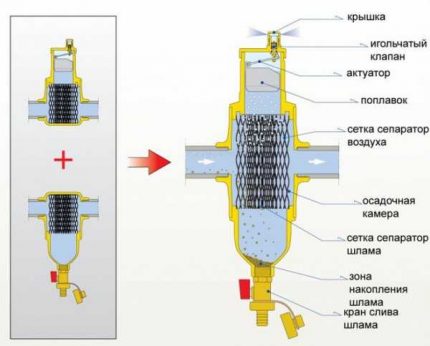
Breakage of the make-up valve can lead to leaks - wear of the valve gasket, mechanical damage to the parts caught between the seat and the scale gasket. If the tap passes, then excess water coming from the water supply system to the heating main increases the pressure in it, because the pressure in the HVS pipeline is always higher. It is necessary to tighten the valve or replace it if it fails.
Air congestion is a common cause of problems with the heating system. They can be caused by malfunctions of the gas boiler itself, problems in the circuit or improper start of heating.
Restarting the system will help fix the problems - its slow coolant fillingstarting from the lowest point until water flows from the highest point of the circuit. All air bleed valves must be open. Airing systems can lead to both increase and decrease in pressure.
The main reasons for reducing pressure
Common reasons why the pressure in the heating gas boiler drops are:
- Coolant leak. Damage to the heating line leads to a leak, loss of heating water and a decrease in pressure.
- Cracks in the heat exchanger. Leaks in the boiler itself will not only lead to a decrease in pressure, but can also provoke more serious equipment failures, damage electronics.
- Rupture of the membrane in the expansion tank. Through damage in the rubber partition, the liquid enters the air compartment and the pressure in the circuit decreases.
To determine the place of leaks in the system, it is fed to normal pressure and the circulation pump is stopped. Step by step, you need to inspect the highway, establish the problem area and troubleshoot.
How accumulator operation affects pressure
Problems with the expansion tank, which affect the pressure in the heating circuit, are very common. An incorrectly calculated volume of an expansomat is one of the most characteristic prerequisites.
Malfunctions can result from improper installation, low or high pressure in the air chamber of the tank, a damaged membrane - each of the reasons can lead to disruption of the circulation of the coolant in the system.
Expansion tank: device features and volume
If a small volume tank is installed in the heating system, it cannot compensate for the expansion of heating water during heating. At a temperature of 85-95 ° C, water expands by about 4% and its excess volume leaves through safety relief valve.
In order for an expanomat to fully perform its compensatory function, its capacity for systems with a gas boiler should be at least 10 percent of the total volume of water in the circuit.
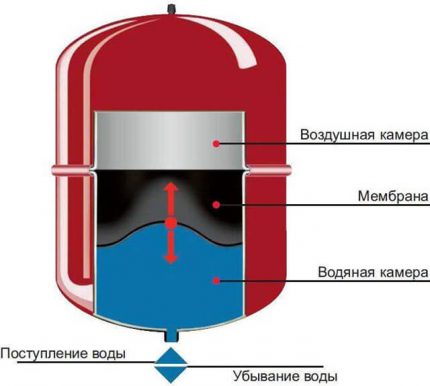
Damage to the tank membrane leads to the fact that water completely fills its volume and the pressure in the circuit drops. If you fill the volume of the circuit by opening the make-up valve, this will create a new problem - when the coolant is heated, it will not expand where and the pressure in the system will increase above normal. The situation can only be corrected by replacing the rubber partition.
Install the tank only on the return pipe, in front of the boiler. So the tank will minimally affect the operation of the circulation pump, which is installed after the gas boiler. In addition, here the water temperature is lower and the negative effect on the pressure in the system and on the tank membrane will be less.
Setting the pressure in the air chamber
The pressure generated in the air chamber of the expansion chamber can also lead to an increase or decrease in pressure inside the heating system. Check and pump air in the tank only if there is no coolant in the tank.
To do this, it is necessary to block access to the general circuit using shut-off valves and to drain the water through the drainage drain. Then the pressure in the air chamber is measured and pumped / lowered to the required values.
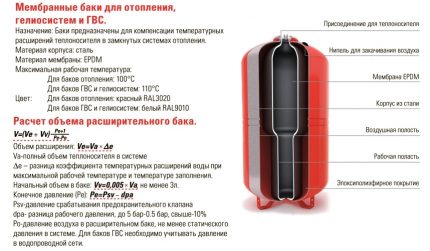
For settings pressure tank in the air chamber should be 0.5 bar higher than the expected maximum pressure in the system. After the pressure in the leveling part of the tank is adjusted, the circuit is filled with cold water to the expected pressure value.
Then the air from the air chamber is lowered until the pressure in the heating circuit and the tank starts to decrease simultaneously - here it is necessary to simultaneously monitor the pressure in the system and in the expansion tank.
In this phase, changes in indicators are hardly noticeable, therefore, it is necessary to be prepared for an immediate cessation of air bleeding from the expansion tank as soon as a simultaneous decrease is detected.
Conclusions and useful video on the topic
Pressure surges in a heating system with a double-circuit boiler:
Why does the pressure in the heating system drop:
Reasons for pressure increase in the heating circuit:
The instability of the pressure in the heating system occurs due to its improper connection, non-compliance with operational rules, and the use of faulty devices.
Understanding the causes of the drop and increase in pressure in the gas boiler helps to properly maintain the system, but this is not a reason to intervene in the operation of the equipment yourself. For help, it is better to contact the master from the gas service supplying blue fuel.
And what problems with the drop or increase in pressure occurred during the operation of your gas boiler? Share the methods that you used to bring pressure to normative indicators. Please leave comments in the form below the block, here you can ask questions and post a photo on the topic of the article.

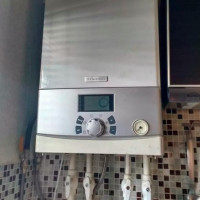 Error E4 in a gas boiler: decryption of code E04 + steps to solve the problem
Error E4 in a gas boiler: decryption of code E04 + steps to solve the problem  Why a gas boiler often turns on and off: the causes of malfunctions and their solutions
Why a gas boiler often turns on and off: the causes of malfunctions and their solutions 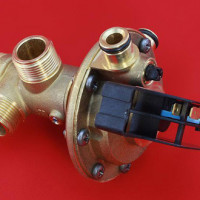 How to check a three-way valve in a gas boiler: DIY valve check instructions
How to check a three-way valve in a gas boiler: DIY valve check instructions  What to do if condensate in a gas boiler: methods for preventing the formation of “dew” in a chimney
What to do if condensate in a gas boiler: methods for preventing the formation of “dew” in a chimney 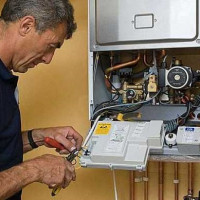 Why does the gas column go out: typical causes and a guide to resolve them
Why does the gas column go out: typical causes and a guide to resolve them 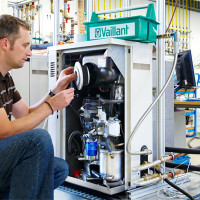 Why the gas boiler is noisy: why the unit is buzzing, clicking, whistling, clapping + how to fight
Why the gas boiler is noisy: why the unit is buzzing, clicking, whistling, clapping + how to fight  How much does it cost to connect gas to a private house: the price of organizing gas supply
How much does it cost to connect gas to a private house: the price of organizing gas supply  The best washing machines with dryer: model rating and customer tips
The best washing machines with dryer: model rating and customer tips  What is the color temperature of light and the nuances of choosing the temperature of the lamps to suit your needs
What is the color temperature of light and the nuances of choosing the temperature of the lamps to suit your needs  Replacement of a geyser in an apartment: replacement paperwork + basic norms and requirements
Replacement of a geyser in an apartment: replacement paperwork + basic norms and requirements